by Michael S. Howard
This is a continuation of "Dionysus and the Historical Tarot 1 - Part II, the second part of four, has the following sections:
A5: Dionysus in Mantua. A6: Ficino, Bessarion, Pico, and Erasmus. A7: Dionysus and Osiris. A8: The d'Este Matto. A9: Other early Matto cards. A10: The other cards, and an objection.
A5: Dionysus in Mantua
Now I want to focus on Mantua, where Alfonso's sister Isabella reigned in art (and contributed significantly to statecraft as well). The two siblings were in continual contact, even rivalry, and Alfonso sometimes sent his own painters to visit there. One painting done for her was Lorenzo Costa's Myth of Comus, 1510-1515, http://en.wikipedia.org/wiki/Comus). It shows drunk revelers and in the foreground a maiden who, probably under the influence of wine, has fallen sleep. According to Ciammitti (p. 87), Nonnus's poem about Nicea was also a source for this painting, the same incident in Nonnus's poem as in the case of Alfonso's Myth of Pan, but before Bacchus did the deed. Here is the relevant detail:
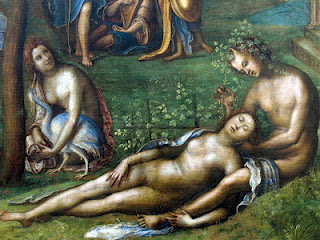
There are problems with this interpretation. Dionysus is not alone with the maiden here. Moreover, she appears to have fallen asleep lying against the male figure. Nor is there anything else to suggest that source. Stephen J. Campbell says that she is merely the sleeping Ariadne (Cabinet of Eros p. 208ff, in Google Books, PA206&lpg=PA206&dq=Lorenzo+Costa+Comus&source=bl&ots=2kX0ilINTz&sig
_Q_Lsd3xVo0&hl=en&sa=X&ei=lc1yT9SgJaqiAK748mCCw&ved=0CGMQ6AEwCg#v=onepage&q=Lorenzo%20Costa20Comus&f=false)
The ivy wreath he is making suggests the crown of stars that will be hers after death. The text being illustrated, he argues, is primarily Philostratus's Imagines, a translation of which was in the possession of Isabella. Either way, the painting is a Dionysian erotic scene. (Comus, from whom the title derives, is the god of revels and companion of Dionysus).
Of interest here is what Campbell says about Isabella and Alfonso (p. 208 again):
§ «Scholars are generally not disposed to thinking of Isabella as being interested in the myths of Bacchus with their connotations of ecstasy and excess; such imagery is typically seen as the preserve of her "libertine" brother Alfonso. Hence, with the exception of Erika Tietze-Conrat, most scholars have been slow to recognize that the Comus is a painting concerned with the myth of Bacchus and Ariadne» §
Campbell argues that the gap in artistic taste between Isabella and her brother is not as wide as others have thought. The same humanist wrote programs for each, and both had artists commission paintings on sensuous Dionysian themes.
Another painting for Isabella is one by Corregio, c. 1530, that Campbell (p. 242) calls Silenus, or Allegory of the Passions; the title Allegory of Vice was given in the 18th century (a good image is at http://cdn2.all-art.org/early_renaissance/images/correggio37-9.jpg). Campbell (p. 235) sees the influence of the Mantuan poet Folengo's Baldus in this work.
Folengo, as I mentioned earlier, is significant here because he was the author of five tarocchi poems in his 1527 work Caos del Triperuno (http://www.tarotpedia.com/wiki/Caos_Del_Triperuno). Here is Folengo in Baldus, as quoted by Campbell:
§ «While Silenus and his consort sleep naked, snoring like pigs, a thousand naked little boys keep watch. And these little boys sing the "Evoe", leaping and performing the moresca, all plump and ripe enough to be cooked to a ragout. Each has a crown of grape leaves on his curly head, each holds a bunch of grapes in his hand, each has a little flask with a stopper that hangs by his side. They al have the wine flush upon them and they laugh and celebrate the bacchanal of their father, and they finally end up drunk themselves» §
To be sure, in Corregio's painting Silenus is not likely sleeping! Silenus is another of Dionysus's companions, his aged teacher; moreover, the whole scene is Dionysian in character. Isabella collected small bronzes of satyrs and other Dionysian figures, according to Campbell.
Still, Alfonso's taste was probably more sensuous than Isabella's. Michelangelo did a "Leda and the Swan" for him, famous for the explicit contact between the two (http://en.wikipedia.org/wiki/Leda_and_the_Swan). Wikipedia says that the painting was "deliberately destroyed" in France later; but several copies survive. Leda seems to be asleep. Fiorenzo's book Dosso Dossi actually has a section entitled "Alfonso's Sleeping Beauties" He apparently liked the idea that Bacchus's gift could make a woman more vulnerable to sex, if not awake then asleep; in Nonnus, they were of both sorts. So for Alfonso, there is Bellini's Feast of the Gods and Dosso's Myth of Pan, already mentioned. Another is a curious piece with the same sleeping lady, watched over by a similar old woman, but instead of Pan we have a lady pointing upwards.
(http://3.bp.blogspot.com/-ER1-pGLoEbA/T3TZmoG2YBI/AAAAAAAAD-s/ptLglNUWJTQ/s1600/dossi05.jpg).
No one has found a satisfactory mythological antecedent for all the major elements. Perhaps Dosso drew on various myths to suggest on the one hand, the sleeper's dream of chastity, and on the other, her posture, however innocent, inviting the dangerous intrusive male gaze, in this case the viewer of the painting. However there may be a higher philosophical rationale, which I will discuss later.
In Mantua, the "Amymone" painted by Lorenzo Leonbruno and engraved by Girolamo Mocetto (Campbell p. 167) is similar to the Myth of Pan and the others, although the god is Neptune (the figure with the trident); both were taken from the Mantegna workshop's engraving on the same theme.
(http://www.engramma.it/engramma_revolution/53/053_saggi_abolympo.html).
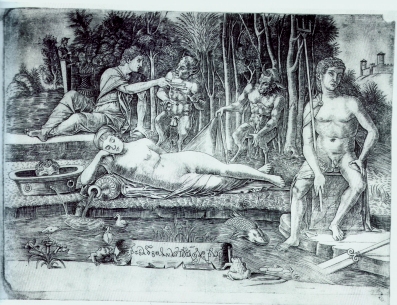
Art historians find the influence in these works from a woodcut in the Hypnerotomachia, 1499 Venice, showing Pan looking down at a sleeping maiden (from Fiorenza, Dosso Dosso, p. 84).
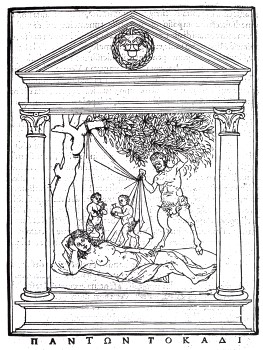
The inscription says, "To the Mother of all". The sense is that Pan (meaning "All" in Greek) is the fecundating spirit that will bring all life-even of art and intellect out of passive Nature (Fiorenza p. 83).
But I think there may be another source for all these works, mostly not mentioned by the art historians. I suspect that all these works portraying an enamored man, or satyr, over a sleeping girl were ultimately inspired by the Roman reliefs and sarcophagi that depicted Dionysus being shown the sleeping Ariadne by Pan. Below are three examples, gleaned from a casual search on Google. You will notice that the face of Ariadne in the middle one is not filled in. Probably the likeness of the deceased, a female initiate into the Dionysian rites, was meant to be inserted there. These things were probably mass-produced.
(If at this point you are wondering why I am going into such detail, well, partly it is to show that even when something isn't on the surface Dionysian, it might prove to have a Dionysian source; and partly it is because I am going to apply the same kind of analysis to the tarot).
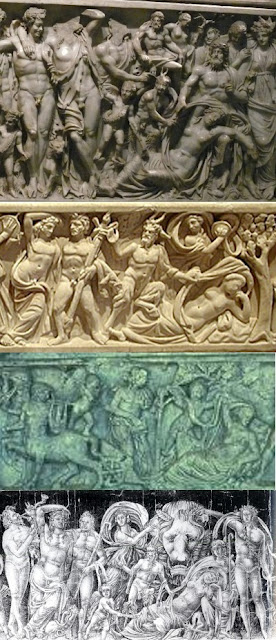
The fourth image, on the bottom, is from a pen and ink drawing done, according to Wendy Sheard (Titian 500, p. 317f) by a "Mantuan artist" c. 1480. She is the one historian I have found who documents the role of the sarcophagi in the art of Mantua of the 15th century (although her point is cited with approval by Campbell). According to her, the sarcophagus itself, now at Blenheim Palace in England (probably identical to the top one in my series), was in Rome at the time. You will notice that the artist has taken some liberties in depicting the scene.
The central group, at left in the drawing and photo, showing Bacchus supported by two satyrs, was made into an engraving by the Bolognese artist Jacopo Francia, c. 1506.The style is noticeably different, showing the influence of Raphael.

In the classical works about Dionysus and his retinue, the theme of Dionysus discovering the sleeping Ariadne, uncovered by Pan, was recycled over and over again, with different maidens and helpers. One example is the the Costa's Comus, with which this section began. Sheard (p. 317) hypothesizes that Titian, for his versions of the sleeping maiden in Bacchanal of the Andreans and elsewhere, saw the drawing when he visited Mantua in 1519 with Dosso. Dosso's Myth of Pan (discussed in my previous section) would then have been similarly inspired.
(To see Andreans again, see http://commons.wikimedia.org/wiki/File:Titian_Bacchanal_1523_1524.jpg;
for Pan, see http://www.getty.edu/art/collections/images/enlarge/00082601.JPG).
Mantegna and his workshop did other works which I think were inspired by Dionysian sarcophagi. The most obvious is a Bacchanal of the 1470s (http://www.metmuseum.org/toah/images/hb/hb_29.44.15.jpg):
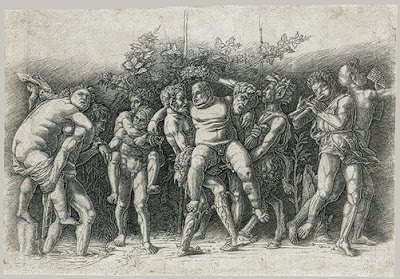
At least two tarot cards are inspired by these engravings, the Two of Batons and the Two of Swords in the Sola-Busca deck, done in either Ferrara or Venice, but more likely the former, in around 1491: the rather gross belly, thigh, and testicles of the 2 of Batons, and the left figure of the 2 of Swords. The forelock represented the saying "grab opportunity by the forelock" and is probably meant as advice to the hesitant youngster; but it also suggests a horn, while his covered legs might hide those of a satyr.

What is the source of the Mantegna engraving? The online Metropolitan Museum commentary (http://www.metmuseum.org/toah/works-of-art/29.44.15) says:
§ «In representing Silenus, any artist living in Mantua, the city of Virgil's birth, would have had in mind the poet's sixth Eclogue, in which Silenus is roused from drunken sleep by two satyrs and a nymph, bound with his own garlands, and forced to sing» §
But I see no garlands binding anyone, no nymphs, and these drunks are not singing. Here is a corresponding sarcophagus scene, now in Naples.
(I take this from Daimonax at http://www.bacchos.org/tarothtm/15diable2.html).
(Notice also the similarity of the young men to the young man on the Sola-Busca 2 of Swords).
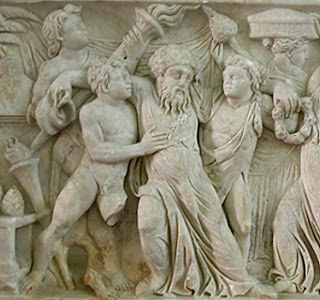
I doubt if anything like this was in Mantua then, but below is an engraving--which I divide into right and left sides, above and below--by Marcantonio Raimondo, who lived c. 1470-1543, originally an engraver in Bologna who moved to Rome in 1510 (http://en.wikipedia.org/wiki/Marcantonio_Raimondi). Raimondo was imprisoned by Pope Clement VIII in 1524 for some erotic engravings based on drawings by Giulio Romano, who was working in Rome just before. The engraving below is not one of those, although at least some of them, too, may have been inspired in part by sarcophagi (for which see Richard Asti: p. 47 of "Giulio Romano as Designer of Erotica", in Janet Cox Rearick, ed., Giulio Romano Master Designer).
Most likely the sarcophagus I am now focusing on was in Rome, and Mantegna either saw it there, or a version on paper there or in Mantua. The engraving (from the British Museum's site at:
http://warburg.sas.ac.uk/vpc/VPC_search/subcats.php?cat_1=5&cat_2=89&cat_3=1408&cat_4=1704&cat_5=1350&cat_6=1030&cat_7=733&cat_8=224) is so long that I divide it into two sections here.
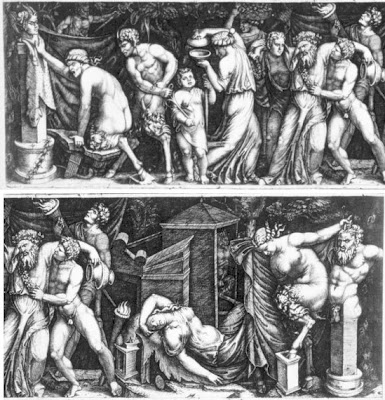
The other part of the engraving is based on another sarcophagus scene, or perhaps a relief, also now in Naples. I don't know if it is the same sarcophagus as the other, but it might be, based on the similar marble surface and quality of preservation;
I get the image, like the other one, from http://www.bacchos.org/tarothtm/15diable2.html:
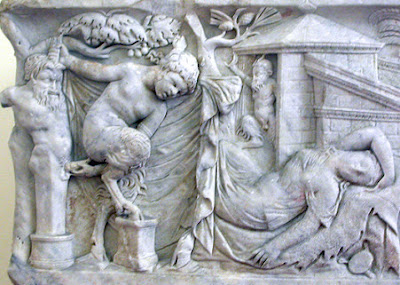
You will have noticed the same pose on the sleeping woman as in many of the paintings (It is this sarcophagus that Asti (referenced above, this section) thought Romano's erotic drawing was based on.) The scene next to it, of anal penetration, might have to do with an episode in the myth of Dionysus as told by Clement of Alexandria (Exhortation to the Greeks 2:30, http://www.theoi.com/Olympios/DionysosMyths2.html). A man showed Dionysus the entrance to Tartarus, on condition that Dionysus have sex with him upon returning. By then the man was dead; so Dionysus carved a phallus out of fig-wood and fulfilled his promise with it. "As a mystic memorial of this passion", Clement says, "phalloi are set up to Dionysos in cities".
On the sarcophagus and engraving, however, a female satyr is being penetrated by such a wooden statue; in this case the wooden phallus symbolizes the god himself; it is the soul's penetration by the god. Augustine says in City of God 7:21 that just such an act was part of the festival of Liber in the Italian town of Lativum. (http://www.newadvent.org/fathers/120107.htm).
After the phallus was dragged to the forum, and then the temple, and wreathed by "the most honorable matron, he says:
§ «Thus, forsooth, was the god Liber to be appeased in order to the growth of seeds. Thus was enchantment to be driven away from fields, even by a matron's being compelled to do in public what not even a harlot ought to be permitted to do in a theatre, if there were matrons among the spectators» §
Augustine cannot bring himself to be more specific, but we know what he means.
In the paintings for the Estensi there is an emphasis on Dionysus's reputation as a reveler, boon companion (of Comus), conqueror, and lover. These roles would not be foreign to the atmosphere of card-playing in the taverns and at private parties, but somewhat removed from the high seriousness of the "divine folly" of union with God. That is where a certain group of 15th century philosophers comes in.
A6: Ficino, Bessarion, Pico, and Erasmus
The fact is that among the Florentine-oriented humanists, if not the monks in Piedmont, the Dionysian/Orphic "orgia" had a good name, much in line with the mystic "divine frenzy" of the Middle Ages. This state of affairs was chiefly due to the efforts of Plethon, Ficino, and Bessarion. On Cosimo's deathbed, Ficino was said to have sung Orphic hymns while accompanying himself on the lyre. These hymns, embedded in the Neoplatonists' writings, had probably been pointed out earlier by Gemistos Plethon, the Platonist philosopher from Greece who had lectured in Florence during the 1438 Conclave there; he had also called attention to the Chaldean Oracles, another system of ecstatic ascent; Ficino later translated and published Plethon's arrangement and introduction of some of them. For Plethon and those after him, these were all manifestations of one prisca theologia, "ancient theology".
In Plato, the Symposium and the Phaedrus were especially influential. In the Symposium, of which Ficino wrote a Neoplatonic interpretation, Plato talks about love of beautiful bodies as the first step toward love of the divine. In the Phaedrus there is a tension between the two horses that pull the soul's chariot, one of which wants to lustfully grab the body of the beautiful boy he has dragged the chariot to, while the other restrains the first. In the allegory, both are necessary: the lustful horse draws the soul near to the beautiful object and makes it feel desire, but the other turns the desire into restrained contemplation, leading to the transformation of low desire into its higher forms.
In Renaissance art, there were two Venuses and two Cupids. For example, Equicola's program for Costa's Comus called for two Venuses and two Cupids, and they are indeed there in the painting (Campbell Cabinet of Eros p. 210f). The popular, earthly Venus (typically shown clothed, as also in Titian's so-called Sacred and Profane Love) is on the right, holding a syrinx between the lyre-player's legs. A wingless Cupid clings insecurely to her shoulder. On the left is the celestial Venus, nude, touching a winged Cupid holding laurel wreaths. (For the whole painting, see http://www.wga.hu/art/c/costa/lorenzo/isabellc.jpg)
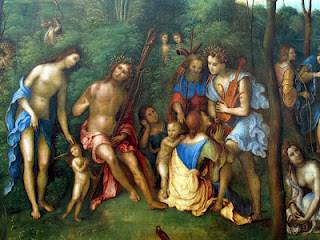
The detail of the laurel wreaths is related to a sonnet by Equicola's friend Paride da Ceresara (quoted in Campbell Cabinet of Eros p. 362; translation and discussion, p. 215, in Google Books,
http://books.google.com/books?id=z_GBq346SKIC&pg=PA206&lpg=PA206&dq=Lorenzo+Costa+Comus&source=bl&ots=2kX0ilINTz&sig=
Bdk7ouStL8ZXgwy9_Q_Lsd3xVo0&hl=en&sa=X&ei=lc1yT9SgJ-aqiAK748mCCw&ved=0CGMQ6AEwCg#v=onepage&q=Lorenzo%20Costa%20Comus&f=false):
Già conteplando in alto i'vedo Amore
nel ciel fra gli altri dei lucido e chiaro
dolce piatoso, stabile e preclaro
con due belli occhi e pien d'ogni valore.
Non arco e strali in man, ma di dolore
celeste un lauro tien, e quel sí caro
porge ad ognun perch'è di nulla avaro,
sol lui mirando il suo divin splendore.
Poi mi rivolgo, ed vedo sparsa in terra
qua l'ombra sua da lui tutta diversa
chiamata Amor, palida, armata e cica.
Alora (sento dir) il se disserra
dal cor un fumo e a gli occhi s'attraversa,
ch'n coral modo il veder nostro acieca.
(Once in contemplation I saw Amor on high, bright and clear among the other gods in heaven, sweet, merciful, eternal and renowned, with two beautiful eyes and full of every virtue; He holds no bow in arrow in hand, but a heavenly laurel crown, and this precious thing he offers to all who only admire his divine splendor, becuse he is no miser. Then I looked back here, and saw here his shadow, totally different from him, let loose on earth: he is acalled Amor, pallid, armed, and blnd. Thus I've herd it said that he lets loose smoke in the heart and enters through the eyes, thus depriving us of our own sight)
In the Platonism known before the Renaissance, however, it was pointedly by renouncing "beautiful bodies" and acting in accord with Christian virtue that one was able to ascend, until one arrived at a truth beyond concepts. This doctrine, that of the docta ignorantia, had been articulated by Augustine (and defended, notably, in the 15th century by Nicholas of Cusa in his De Docta Ignorantia, 1440). Henry Chadwick, in Augustine, pp. 52-53 (in Google Books, a different edition, at
http://books.google.com/books?id=HuxXNesm9dYC&pg=PT90&lpg=PT90&dq=Augustine+docta+ignorantia&source=bl&ots=G8lfAm6FsS&sig=
rhsqPBFuaF_WJdlIWCfbFgpZMAE&hl=en&sa=X&ei=lI6ET4GRFqHaiQLIj831BA&ved=0CDsQ6AEwBQ#v=
onepage&q=Augustine%20docta%20ignorantia&f=false; scroll up slightly), says, quoting Augustine:
§ «"We move toward God not by walking but by loving " (non ambulando, sed amando)... .Hence the negative path, which surrounds the idea of God with exclusively negative epithets, is not the only way. Certainly we can more easily say what God is not than what he is. But at least our ignorance is informed, docta ignorantia (E [Epistulae] 130.28)... Here Augustine made his own a paradox he found in Porphyry. The contemplation of God is beyond intellection, and "somehow such things are known by a not knowing, and so by this kind of knowing a mysteriousness is realized" (CD [De Civitas Dei] xii.7; C [Confessiones] xii.5)» §
But in Augustine's hands "loving" means, if we are attain to the divine state, its higher form of morality. Chadwick quotes Augustine, in a sentence I omitted from the quote above:
§ «"Not our feet but our moral character carries us nearer to him. Moral character is assessed not by what a man knows but what he loves" (E [Epistulae] 155.13)» §
Yet to that extent, Augustine's continuation of Plato neglects sensual love. It is this one-sided sublimation of desire that Ficino's reading of Plato corrects. The two Venuses do not oppose each other, nor do they demand a choice between them. One quotation from Alfonso's adviser Equicola (Book VI of La redazione, 504 (261V)) is largely a reflection on Ficino's commentary, as Campbell observes (p. 214, in Google Books), while finding its emphasis on pleasure "Lucretian" (i.e. materialistic). I myself am not at all sure that Plato, or Ficino, would have disagreed with what Equicola is saying:
§ «Non refugemo da le volupta deli sensi quanto sustentatione solo di natura et nostro bene essere rechiede; siamo in volupta del'animo per scientie, et coniugendola con operatione di virtu procuremo devenamo religiosi, che per questa via, con guida di amore, ascenderemo alla vera felicita...
(We do not flee the pleasure of the senses insofar as the sustenance of nature and our well being requires it; knowledge brings us pleasure of the mind, and in joining this with virtue we become religious, so that by this path, with the guidance of love, we ascend to true happiness)» §
While carefully not denying the doctrine of Augustine, Equicola indicates a process underlying the Dionysian paintings that Alfonso commissioned. Campbell says something similar about the paintings, although not referring to Plato and Ficino (Cabinet of Eros p. 256):
§ «The effect is that Stoical and Petrarchan ideals of vita contemplativa are placed in dialogue with vivid mythological exempla of passion and sensation)» §
And later (pp. 262-3)
§ «The viewer is put in the position of being acutely conscious of his or her relation to the sensational world of the images, and of the relation between tranquil contemplation and the bodily pleasures of the painted fables. ...The point is not to deny that the powers of Bacchus and Venus can find their analogy in the visual and tactile appeal of painting, but that a certain privileged beholder's enjoyment of the paintings is reconfigured and reframed as a philosophical exercise...» §
The paintings thus encourage disengagement and contemplation of beautiful forms while giving lust its due; the intrusive male gaze is satisfied without any actual intrusion and is afforded the beginning of an upward, if non-philosophical, movement toward Apollonian heights.
There is in these Dionysian paintings a foreshadowing of higher realms, as Joseph Manca argues in "What is Ferrarese about Bellini's Feast of the Gods?" (in Titian 500, ed. Manca, pp. 301-313). He sees depictions of three levels, "bestial, terrestrial, and celestial, and it was intended to ennoble the god Bacchus, who aided love and desire in all of their various forms" (p. 307). Specifically: (p. 306)
§ «In the Feast of the Gods the frustrated act of Priapus is the object of derision, and it differs from the satisfying fulfillment of earthly love represented elsewhere in the camerino. The paintings by Titian for the camerino contain a good deal of ribald, earthly activity, but they explicit homage to elevated forms of love. In his Worship of Venus (now Prado, Madrid), the goddess is placed high against the sky to suggest the heavenly nature of love. Raising a figure up in this way connotes a higher level of existence, whether is the Heavenly Venus in Titian's own Sacred and Profane Love (Galleria Borghese, Rome) or Mary as the Regina caeli. In Titian's Bacchanal of the Andreans, the lofty level of love is suggested, first, by the presence of married couples among the mortals, second by the reference to wine in the text as a "divine beverage", third, by the raising of the wine against the sky, and finally, by the association of gods and mortals, which reflects the blending of earthly and divine forms of marriage. Titian gives his clearest indication of celestial love in the Bacchus and Ariadne: the heroine is seized by the god, and her reward for submitting to the matrimonial union is to take her place in the heavens through metamorphosis into stars (fig. 6). Physical love occurs on earth, but it results in a heavenly, sidereal reward» §
The relevant details in the paintings for Alfonso are below, in Worship of Venus, Bacchanal of the Andreans, and Bacchus and Ariadne, all by Titian (Manca's fig. 6 is of this last, of which the relevant detail is at right):

I am not sure if the couples in Bacchanal of the Andreans are meant as married. But they are certainly not bestial (http://upload.wikimedia.org/wikipedia/commons/b/b0/Titian_Bacchanal_1523_1524.jpg).
Another consideration that Manca brings out is the lost series of frescoes in the Hall of Cupid and Psyche at Belriguardo in the 1490s, under the supervision of Ercole Roberti. We don't know their content, but it can be deduced readily enough from the countless works on that theme on marriage chests and indeed in another fresco cycle by Giulio Romano in late 1420s Mantua. As told by the 2nd century Platonist Apuleius, in his Golden Ass (printed in Latin, 1459, translated into Italian by Matteo Boiardo c. 1480), it is an allegory of the soul's progress from innocence through suffering, including a journey to Tartarus and subsequent death, to the company of the gods. Thus it embraces both the human and the celestial phases of love. With its evident analogy to the Christian path, it is also a ready model for the progress of the tarot trumps, as I shall attempt to show in an Appendix at the end this essay, after I have discussed all 22 of the individual cards.
(In a footnote, Titian 500, p. 313, Manca gives his documentation:
§ «That the Cupid and Psyche cycle was a moral allegory of the journey of the soul was stated clearly by Sabadino himself; see Gunersheimer 1972, 62-65; and Gundersheimer 1976, 10-18. Niccolo Maria d'Este, in a letter of 1498 to Ercole I, also made it clear that the fresco cycle of Cupid and Psyche was an allegory of "the Soul, and the disturbances which accompany it:; see Gunersheimer 1976, 14. There is less consensus about whether there is any moralizing intent in the other great cycle of Cupid and Psyche, that by Giulio Romano in the Palazzo del Te; see Rodolfo Signorini, La "Fabella" di Psiche e altra mitologia [Mantua 1983], 14-16)» §
I have not made reference to Renaissance philosophical writings on Dionysus himself and his mysteries. For that, here is one passage from Ficino, quoted in Wind's Pagan Mysteries of the Renaissance, p. 62:
§ «The spirit of the god Dionysus was believed by the ancient theologians and Platonists to be the ecstasy and abandon of disencumbered minds, when partly by innate love, partly at the instigation of the god, they transgress the natural limits of intelligence and are miraculously transformed into the beloved god himself: where, inebriated by a certain new draft of nectar and by an immeasurable joy, they range, as it were, in a bacchic frenzy. In the drunkenness of this Dionysiac wine our Dionysius expresses his exultation. He pours forth enigmas, he sings in dithyrambs... To penetrate the profundity of his meanings....to imitate his quasi-Orphic manner of speech, we too require the divine fury...» §
By "our Dionysius", with "-ius", Ficino means "Dionysius the Areopogyte", the Greek Christian mystic who had put Proclus's Neoplatonic "henads" in a Christian context as choirs of angels. The "dithyramb" is a verse-form particularly associated with the god Dionysus in Greek writings; whereas the "thriambos" was a hymn of victory, the "dithyramb" was the verse of tragic drama.
In the Platonic Theology, published 1469, Ficino distinguished nine Dionysi and made them the sources of knowledge behind the nine Muses (quoted by Thomas Taylor, The Hymns of Orpheus, 1792, at http://trionfi.com/0/m/13/; this passage was drawn to my attention by "Huck" on Tarot History Forum). After enumerating Dionysus under each of nine epithets, one for each muse and each of the nine celestial spheres (leaving the tenth for Apollo), he concludes: ...
§ «From all which the Orphic theologers infer, that the particular epithets of Bacchus are compared with those of the Muses on this account, that we may understand the powers of the Muses, as intoxicated with the nectar of divine knowledge; and may consider the nine Muses, and nine Bacchuses, as revolving round one Apollo, that is about the splendor of one invisible Sun» §
The same passage, in English and Latin, made be found on pp. 294f of Ficino's Platonic Theology, as translatedby Michael B. J. Allen and John Warden, in Google Books at
http://books.google.com/books?id=zr_XMwcvsB4C&pg=PA295&lpg=PA295&dq=Ficino+Platonic+Theology+muses+Bacchus&source
=bl&ots=Th12lzkmoJ&sig=xDOB5XqpMHLGiCa1bJB5Sw635Ww&hl=en&sa=X&ei=L6aLT9j_G6mXiA
Kt75C1CQ&ved=0CB4Q6AEwAA#v=onepage&q&f=false.
The Muses did not include painters. But it is perhaps with such a passage in mind that Bellini signed his name to the canvas of Feast of the Gods, It is on the wine vat next to Liber and Libera (or Priapus and Lotis, if you prefer). In this festival of fertility, the wine of Dionysus is his fertilizing inspiration as well.

Manca notes that this painting, Feast of the Gods, is related to a theme of the Cupid and Psyche fresco cycles. The last scene was of a banquet of the gods, on the occasion of the birth of Cupid and Psyche's child, whom in the tale told by Apuleius is named Voluptas, pleasure. (For Romanos' version, see the Appendix to this essay). We may see Bellini's painting in the same light: Dionysian inspiration on the fertile soil of an inspired painter results in something of the highest pleasure, delighting the mind as well as the eye.
I turn now, briefly, to Bessarion, chiefly known for his learned defense of Plato over Aristotle, Called the Calumniator and published in 1469, the same year as Ficino's Platonic Theology.. But his relationship with the mystical, Orphic Plato went back many years. In a letter to the sons of Gemistos on the occasion of their father's death, sometime between 1452 and 1454, he wrote:
§ «Il cardinale Bessarione saluta Demetrio e Andronico, figli del sapiente Gemisto. Ho appreso che il nostro comune padre e maestro ha deposto ogni spoglia terrena e se n'è andato in cielo, al sito di ogni purità, per unirsi al coro della mistica danza di Jacco [id est il Dioniso dei Misteri di Eleusi - ndr] con gli dèi olimpici.
(http://www.ritosimbolico.net/studi2/studi2_22.html)
(Cardinal Bessarion greets Andronicus and Demetrius, children of learned Gemistus. I learned that our common father and teacher has deposited everything earthly and gone to heaven, the site of every purity, to join the choir of the mystical dance of Iacco [i.e. the Dionysus of the Mysteries of Eleusis] with the Olympian gods)» §
People would have known "Iacco" as a name of Dionysus from various sources. For one, he is called that in Aristophanes' Frogs, by the Chorus in line 316 (Loeb edition p. 70). At this time, 1452-1454, Bessarion was serving as papal legate in Bologna.
Now let us look at Pico. His 1486 900 Theses, besides Kabbalah and many other subjects, included a section on Orpheus, i.e. the philosophical cult in Greece and Rome that utilized Dionysian themes. Likewise, Pico's Oration of 1487 says (http://history.hanover.edu/courses/excerpts/350pico.html):
§ «...These initiates, after being purified by the arts which we might call expiatory, moral philosophy and dialectic, were granted admission to the mysteries. What could such admission mean but the interpretation of occult nature by means of philosophy? ... then, smitten by the frenzy of the Muses, we shall hear the heavenly harmony with the inward ears of the spirit. Then the leader of the Muses, Bacchus, revealing to us in our moments of philosophy, through his mysteries, that is, the visible signs of nature, the invisible things of God, will make us drunk with the richness of the house of God...» §
In another part of his Oration he invokes Osiris and Apollo:
§ «When we shall have been so prepared by the art of discourse or of reason, then, inspired by the spirit of the Cherubim, exercising philosophy through all the rungs of the ladder - that is, of nature - we shall penetrate being from its center to its surface and from its surface to its center. At one time we shall descend, dismembering with titanic force the "unity'' of the "many,'' like the members of Osiris; at another time, we shall ascend, recollecting those same members, by the power of Phoebus, into their original unity. Finally, in the bosom of the Father, who reigns above the ladder, we shall find perfection and peace in the felicity of theological knowledge» §
By "the ladder" he means Jacob's ladder, as is clear in sentences just before this quote; he is invoking the same ladder as in the "Holy Mountain" and other devotional texts, the series of steps that Andrea has called the "mystical staircase".
The reference to "dismembering with titanic force" is to an aspect of two myths, that of Osiris and of Dionysus; the body of each is chopped into pieces by the Titans. Here is Diodorus on the dismemberment of Osiris (Library of History IV:6):
§ «...in ancient times the Titans formed a conspiracy against Osiris and slew him, and then, taking his body and dividing it into equal parts among themselves, they slipped them secretly out of the house...» §
And similarly of Dionysus (Book V: 75, at
http://penelope.uchicago.edu/Thayer/E/Roman/Texts/Diodorus_Siculus/5D*.html:
§ «...and Orpheus has handed down the tradition in the initiatory rites that he was torn in pieces by the Titans» §
I will discuss the further implications of this dismemberment in more detail when I come to the Fool and Death cards.
Pico's close companion in later years was Poliziano, who first identified Nonnus's Dionysica and also edited the relevant Catullus poems (although in an allegedly obscene way that Aldus's editors later considered inappropriate). Poliziano, with Lorenzo de' Medici himself, wrote poems in praise of Bacchus. The most well
known is Poliziano's maenads-song in imitation of Euripides
(http://eternalbacchus.wordpress.com/2011/08/09/fabula-di-orfeo-by-angelo-poliziano/).
After Ficino and Pico came Erasmus. There were others, but Erasmus is important both because he did not shrink from endorsing Ficino when the occasion called for it, and because he was beloved by the Estense. Humfrey and Lucco observe (p. 222):
§ «...Erasmus was well known and widely read in Ferrara and at the Este court, even after he had been condemned and his writings began to be regarded with suspicion. It is not by chance that in 1549 Pietro Lauro of Modena dedicated his translation of Erasmus's Colloqui to Renee of France, Ercole's wife» §
Since so much of Erasmus's work had to do with trying to heal the split in Christendom that came about with Martin Luther, he was particularly relevant to the ruling household in Ferrara: Alfonso's son Ercole II, in marrying the daughter of the king of France, had married someone who would soon become a staunch convert to Calvinism (p. 90). Erasmus was someone they could all enjoy.
Erasmus was an Augustinian monk and as such knew and endorsed the doctrine of docta ignorantia and ascent through love as expressed by good works. For our purposes, what is important is his most popular work, Praise of Folly, first published 1511, with scores of editions in many languages after that. It is mostly a relentless series of mocking commentaries on the pretensions of the powerful, whether in the universities, the church, secular government, or business, when compared with the simple faith of the ignorant apostles. The only times his persona Folly becomes serious is when speaking of the Bible, Origen, or Ficino.
On Bacchus, he cannot refrain from pointing out that one of the names he was given was synonymous with foolishness in Greek, as in the saying ":more foolish than Morychus". "Nor does he take offense when given the name", Erasmus comments (sect. 15; p.83 of.of Radice translation, 1993). ("Morychus" was an epithet of Dionysus reported by Athenaeus, Radice says in a note, p. 83). The reason he looked foolish was that country-people would smear his statues with wine-must and fresh figs, so that he looked ridiculous,. Erasmus goes on:
§ «Then think of the insults flung at him in Old Comedy! "Stupid god", they would say, "just the sort to be born from a thigh". Yet who wouldn't choose to be this light-hearted fool who is always young and merry and brings pleasure and gaiety to all, rather than "crooked-counselled" Jupiter who is universally feared...» §
More seriously, here is a passage (section 38, p.120f of translation) that aptly summarizes Ficino on the subject-matter of Plato's Symposium and illustrates something in Estensi art, as well as the "mystical staircase" of the tarot:
§ «In Plato Socrates shows how a single Venus and a single Cupid are divided into two, and so these masters of dialectic should really have distinguished between two forms of insanity, if they wanted to appear sane themselves. For not every form of insanity is a disaster, or Horace would not have asked, "Or is it fond insanity deceiving me?" And Plato would not have counted the frenzy of poets, seers, and lovers amongst life's chief blessings, nor would the sibyl have called the great undertaking of Aeneas insane.
The nature of insanity is surely twofold. One kind is sent from hell by the vengeful furies whenever they let loose their snakes and assail the hearts of men with lust for war, insatiable thirst for gold, the disgrace of forbidden love, patricide, incest, sacrilege, or some other sort of evil, or when they pursue the guilty, conscience-stricken soul with their avenging spirits and flaming brands of terror. The other is quite different, desirable above all, and is known to come from me. It occurs whenever some happy mental aberration frees the soul from its axious cares and at the same time restores it by the addition of manifold delights. This is the sort of delusion Cicero longs for as a great gift of the gods in a letter to Atticus, for it would have the power to free him from awareness of his great trouble» §
The idea of a single Venus becoming two comes from Pausanias's speech in the Symposium:(this Pausanias is not the third century travel writer, obviously): the two Venuses are Aphrodite Pandemos and Aphrodite Urania, Popular and Celestial Venus.
It appears, in the passage just quoted from Erasmus, that he is talking abut delusion as well as diversion, as long as the delusions do not interfere with living a morally praiseworthy life.In fact, delusions can help one to lead a moral life, making one affable to to others and not vengeful against wrongs that being ignorant of haven't hurt one (e.g. an unfaithful spouse, as in Alione's Frotula). But later he discusses Plato's Allegory of the Cave, and notes that someone who had come back to the cave after having seen what was outside would be declared mad. One cannot tell the symptoms of delusion from those of knowing the truth. Finally at the end of the book he refers to the mystical experience of St. Paul himself, and even life in heaven, as forms of madness: "the supreme reward for man is no other than a kind of madness" (section 67; p. 206). He argues the point from Plato in the Phaedrus (243b) and quotes from St. Paul (I Corinthians 2:9 and the beginning of 2 Cor. 12); but I won't quote from them, and instead give a condensed version of Erasmus's argument for Folly's statement just quoted (section 67, p. 206ff):
§ «First consider how Plato imagined something of this sort when he wrote that the madness of lovers is the highest form of happiness....Moreover, the more perfect the love, the greater the madness--and the happier...What, then, will life in heaven be like, to which all pious minds so eagerly aspire? Then the spirit will itself be absorbed by the supreme Mind...So those who are granted a foretaste of this - and very few have the good fortune - experience something which is very like madness. They speak incoherently and unnaturally, utter sound without sense, and their faces suddenly change expression...Then when they come to,...all they know is that they were happiest when they were out of their senses in this way, and they lament their return to reason, for all they want is to be mad for ever with this kind of madness. And this is only the merest taste of the happiness to come» §
With that the book ends, except for a few jokes, such as "I hate a fellow-drinker with a memory", the ironic hope that the audience will forget what she, Folly, has said. The book ends
§ «Clap your hands, live well, and drink, distinguished initiates of FOLLY. The End» §
When Folly says "drink", we must bear in mind that in section 66 she had just been discussing the sacrament of the Eucharist, which for the pious "represents the extinction of their bodily passions, laying them in the tomb, as it were, in order to rise again to a new life" (p. 205). If the goal of the "mystical staircase" is such a state, the road to it is a Dionysian one, through death-defying folly todivine ecstasy and madness, one that is as compelling as it is absurd, as self-indulgent as it is self-denying. In such circumstance, what can one do but play a friendly game of cards? But perhaps, if one chooses a certain deck, the game of the Fool, the paradoxes will follow one even there.
A7: Dionysus and Osiris
By the Greeks and Romans, Osiris was considered just another manifestation of Dionysus, and the Renaissance followed suit, as we saw in the rather free mixing of the two in Pico's Oration. An ancient example is the text by Cicero quoted by Andrea that Ernesti later edited. As part of Cicero's collected works, it was printed by Sweinheim and Pannaratz in 1471. An edition in Venice followed the same year and again in 1494 (Pease p. 90); Milan followed in 1498. It was often included with Cicero's De divinatione, from which I have already quoted.
In this work, De Natura Deorum, Cicero says explicitly that the two deities, Dionysus and Osiris, are one and the same, Book III p. 58 (http://www.thelatinlibrary.com/cicero/nd3.shtml,
translated at
http://www.theoi.com/Olympios/DionysosGod.html):
§ «Dionysos multos habemus: primum Iove et Proserpina natum; secundum Nilo, qui Nysam dicitur interemisse; tertium Cabiro patre, eumque regem Asiae praefuisse dicunt, cui Sabazia sunt instituta; quartum Iove et Luna, cui sacra Orphica putantur confici; quintum Nyso natum et Thyone, a quo trieterides constitutae putantur.
(We have a number of Dionysi. The first is the son of Jupiter and Proserpine; the second of Nile--he is the fabled slayer of Nysa. The father of the third is Cabirus; it is stated that he was king over Asia, and the Sabazia were instituted in his honour. The fourth is the son of Jupiter and Luna; the Orphic rites are believed to be celebrated in his honour. The fifth is the son of Nisus and Thyone, and is believed to have established the Trieterid festival)» §
The one "of the Nile" is the Egyptian Osiris. Cicero would have learned about him from Herodotus, Book II of his Histories. There Herodotus says (http://classics.mit.edu/Herodotus/history.2.ii.html).
§ «Such Egyptians as possess a temple of the Theban Jove, or live in the Thebaic canton, offer no sheep in sacrifice, but only goats; for the Egyptians do not all worship the same gods, excepting Isis and Osiris, the latter of whom they say is the Grecian Bacchus» §
Herodotus also describes their rites in a way that shows us something about the Greek ones. (If it sounds familiar, it is because I quoted part of this passage in section 4.)
§ «To Bacchus, on the eve of his feast, every Egyptian sacrifices a hog before the door of his house, which is then given back to the swineherd by whom it was furnished, and by him carried away. In other respects the festival is celebrated almost exactly as Bacchic festivals are in Greece, excepting that the Egyptians have no choral dances. They also use instead of phalli another invention, consisting of images a cubit high, pulled by strings, which the women carry round to the villages. A piper goes in front, and the women follow, singing hymns in honour of Bacchus» §
Herodotus was translated into Latin as part of the great translation project initiated by Pope Nicholas V. The Latin translation of Herodotus' Histories was printed in 1474, first by Pannartz in Rome and again in the same year in Venice, according to WorldCat.
A well-known account of Roman Osiris rituals in Latin was in Apuleius's Metamorphoses, popularly known as The Golden Ass. It was first printed in 1469, one of the first books published in Italy, by Sweynheym and Pannartz. Other editions followed, in 1488 Vicenza, 1493 Venice, and 1500 Bologna. Matteo Boiardo translated it into Italian around 1480 (Fiorenza, Dosso Dosso, p. 46). In it we see similar parallels between the two cults, Isis and Dionysus. In her initial appearance to Lucius, Isis announces who she is known by names; some of them are also mentioned elsewhere as mothers of Dionysus (in Marvin Meyer, The Ancient Mysteries, in Google Books, p. 179; it is Book 11 p. 5):
§ «The three-tonged Sicilians call me Stygian Proserpine. The Eleusinians call me the ancient goddess Ceres» §
The Isis procession that follows the next day, as predicted by the goddess in Lucius's dream, has much in common with Dionysian processions as seen on Roman sarcophagi and described in accounts of Dionysus. They make a noisy racket, although with sistra rather than pipes and cymbals. They carry vessels. There is a "winnowing fan" and "an amphora", both seen on sarcophagi (p. 182 in Meyer, Book 11 p. 10). And most tellingly (also p. 182, but p. 11 of the Latin text),
§ «Another man carried the chest that contained the Secret Things of her unutterable mystery» §
Clement of Alexandria, in an essay designed to ridicule the "mysteries", described a chest in the Greek mysteries; containing the "virilia of Dionysus".
Here is what Clement says (http://www.theoi.com/Text/ClementExhortation1.html):
§ «The Corybantes ...got possession of the chest in which the virilia of Dionysus were deposited, and brought it to Tyrrhenia [Lemnos], traders in glorious wares! There they sojourned, being exiles, and communicated their precious teaching of piety, the virilia and the chest, to Tyrrhenians for purposes of worship. For this reason not unnaturally some wish to call Dionysus Attis, because he was mutilated» §
According to WorldCat, Clement's work, including the text relevant here (Exhortation to the Greeks), was published in Latin in 1502. It would have existed in Greek manuscript before that.
Again, in the eyes of the Renaissance, we have a case of the same god worshiped in similar fashion in two countries. If not from Herodotus, they knew from Diodorus what Isis held sacred (Book IV, p. 6). I put in bold print the most important words on this question:
§ «...in ancient times the Titans formed a conspiracy against Osiris and slew him, and then, taking his body and dividing it into equal parts among themselves, they slipped them secretly out of the house, but this organ alone they threw into the river, since no one of them was willing to take it with him. But Isis tracked down the murder of her husband, and after slaying the Titans and fashioning the several pieces of his body into the shape of a human figure, she gave them to the priests with orders that they pay Osiris the honours of a god, but since the only member she was unable to recover was the organ of sex she commanded them to pay to it the honours of a god and to set it up in their temples in an erect position» §
On the identity of the two gods, there was also Plutarch,
On Isis and Osiris 35
(http://penelope.uchicago.edu/Thayer/E/Roman/Texts/Plutarch/Moralia/Isis_and_Osiris*/B.html):
§ «That Osiris is identical with Dionysus who could more fittingly know than yourself, Clea?» §
Clea is the priestess at Delphi to whom Plutarch is addressing the work. He then compares the two: in the procession to bury the Apis bull, observing:
§ «... the priests...indulge in shoutings and movements exactly as do those who are under the spell of the Dionysiac ecstasies....For the same reason many of the Greeks make statues of Dionysus in the form of a bull...Furthermore, the tales regarding the Titans and the rites celebrated by night agree with the accounts of the dismemberment of Osiris and his revivification and regenesis» §
I have not been able to determine whether Plutarch's essay was available in Latin in the 15th century. According to Ingrid D. Rowland, The Culture of the High Renaissance, p. 50, it was; she cites no evidence, but her claim makes sense, given the intense interest in the Osiris myth at that time. The Moralia, of which the essay was a part, was first printed in 1509 Venice, according to Babbit, editor of the Loeb edition (p. xxiii). But before that many essays had been printed in Latin translation, he says (p. xxviii). I see on WorldCat that Latin translations of some of his philosophical works were printed in 1477, but I don't know which ones. Also, manuscript editions were readily available to people with the right credentials in the centers of learning. The 1509 Greek edition was based primarily on the manuscripts of Bessarion, which he had willed to the city of Venice at his death in 1469 (p. xxiv). These manuscripts were quite easy for noble citizens of the city to get on loan, requiring only a signature (Lotte Lobowsky, Bessarion's Library and the Biblioteca Marciana: Six Early Inventories, Rome 1979, which I quote extensively at http://forum.tarothistory.com/viewtopic.php?f=11&t=613&p=8936&hilit=bessarion#p8936).
And here is a poem by the ancient Latin poet Tibullus that merges the two gods Dionysus and Osiris (http://infomotions.com/etexts/gutenberg/dirs/etext06/eltib10.htm), in an elegy touching on the miracle of the rising of the Nile, and to what the Egyptians attribute it:
..On thee they call! Or in sepulchral shade,
The life-reviving, sky-descended powers
Of bright _Osiris_ hail,--
While, wildly chanting, the barbaric choir,
With timbrels and strange fire,
Their Memphian bull bewail.
Osiris did the plough bestow,
And first with iron urged the yielding ground.
He taught mankind good seed to throw
In furrows all untried;
He plucked fair fruits the nameless trees did hide:
He first the young vine to its trellis bound,
And with his sounding sickle keen
Shore off the tendrils green.
For him the bursting clusters sweet
Were in the wine-press trod;
Song followed soon, a prompting of the god,
And rhythmic dance of lightly leaping feet.
Of Bacchus the o'er-wearied swain receives
Deliverance from all his pains;
Bacchus gives comfort when a mortal grieves,
And mirth to men in chains.
Not to Osiris toils and tears belong,
But revels and delightful song;
Lightly beckoning loves are thine!
Garlands deck thee, god of wine!
We hear thee coming, with the flute's refrain,
With fruit of ivy on thy forehead bound,
Thy saffron vesture streaming to the ground.
And thou hast garments, too, of Tyrian stain,
When thine ecstatic train
Bear forth thy magic ark to mysteries divine.
Of course in Diodorus it is Dionysus who is credited with the invention of the plow. I found this poem quoted by Cartari, 1647 edition; this work on mythology was first published in 1556. If Cartari knew it, certainly humanists before him did as well.
For our purposes, the point is that anyone wishing to project Dionysus onto the tarot trumps of the late 15th and early16th century would have had much more relevant imagery to choose among if the myths of Osiris, as presented by the Greek and Latin authors, was also available to them.
Isis was well enough known even in 1445 that in Ferrara there was a theatrical production called Iside in that year, in which the future Ercole I allegedly participated. Also, Ciriaco of Ancona visited Egypt as far as Cairo in 1435, taking numerous notes and copying inscriptions. He then talked with others of his experiences, including one visit to Ferrara at least, in 1449; it is mentioned primarily because he described what he saw of Belfiore, Leonello's country estate, including most importantly the paintings of the Muses there.
Thus Osiris was very much in the ascent by the late 1490s. The Borgia Pope Alexander VI not only traced his ancestry back to Osiris, but had his apartments decorated with frescoes illustrating the myth of Isis and Osiris as presented by Diodorus, featuring prominently the Borgia Bull, now the Apis bull, incarnation of Osiris:
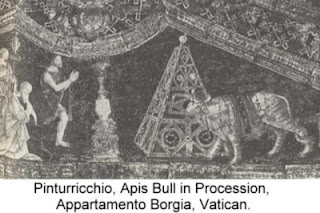
Not to be outdone, the Emperor had his genealogy done, too, showing him with the same ancestor, and had Durer draw him surrounded by what were considered hieroglyphs:

Many of the texts--Apuleius, Herodotus, Diodorus, Plutarch, Clement--also talked about the "hieroglyphs", ancient pictures that meant common ordinary things like birds and oxen to the vulgar but divine things to the wise (see my posts at http://forum.tarothistory.com/viewtopic.php?f=11&t=603). They were not tied to Egypt: it was believed that the Romans also used them, and they existed alongside ordinary phonetic writing, for the most sacred things. Many Italian writers discoursed on hieroglyphs in this way, including Filelfo in Milan but most famously Alberti in his The art of building, in ten books, in manuscript from about 1450, augmented until his death in 1472 and printed in 1485. Of the Egyptians' sacred writing he said (p. 256 of Rykwert et al trans.),
§ «the method of writing they used could be understood easily by expert men all over the world, to whom alone noble matters should be communicated» §
He quickly added that the Romans used this method as well. As such, the humanists could make up hieroglyphs themselves; the most famous early example was Alberti's "winged eye", c. 1438 (Wind, Pagan Mysteries of the Renaissance). And in 1499 Venice came the Hypnerotomachia (Strife of love in a dream). a fantasy novel that pictured and sometimes deciphered many such constructions.
So likewise the tarocchi cards themselves could become hieroglyphs, meaning a way of writing in pictures that would hide their deeper meaning from the vulgar but disclose it to the wise. This word "hieroglyph" was in fact applied to the 22 special cards in the Anonymous Discourse of c. 1570 in northeastern Italy, and also in other works, 1603 and 1676, as quoted by Ross G. R. Caldwell at http://www.tarotforum.net/showthread.php?t=94755.
The literature about Dionysus, to be sure, surpassed that of Isis and Osiris. In Latin, there was, besides the things I have already mentioned, a graphic depiction of suppressed rites in Rome in Livy's History of Rome. Also, Ovid treated of Dionysus in the popular Metamorphoses, Ars Amore and Fasti. There was also Virgil's Georgics, of which Dionysus was a main subject.
In Latin translation, Plutarch made incidental comments about Dionysus and his followers in his Parallel Lives, a highly popular book, first published in Latin translation in 1470 Rome, then 1478 Venice and often thereafter. The main lives of relevance are Theseus, in which we learn much about his wife Ariadne, Mark Antony and Alexander the Great.
Also originally in Greek but translated before 1505, there were also the dramatists, notably Euripides' Bacchae and Aristophanes' Frogs; in both, Dionysus is a major character. Euripides' play had been known in manuscript since the 14th century in Italy (Loeb edition, p. liv) and was printed in Greek and Latin in 1503 Venice. Aristophanes' Frogs ("Batrichoi": the Bacchantes croaked like frogs) in Greek and Latin was printed in 1498 Venice. There was also the Church Father Clement of Alexandria, whom I have already quoted. There were references to the "mysteries", mainly Orphic, in Plato's works, as translated by Ficino and others. (For more on Plato's Orphic aspect, see Graeme Nicholson, Plato's Phaedrus and the Philosophy of Love. pp. 132ff and Robert McGehey, The Orphic Moment: From Shaman to Poet-thinker in Plato, Nietzsche, and Mallarme, pp. 37ff.).
In Greek only during this period, there were the references in Neoplatonist works, the accounts of local cults in Pausanias's Description of Greece. I have already mentioned the very long Dionysiaca by Nonnus, printed in starting 1507, and in 1569 with a Latin translation, but known as such to humanists and artists since Poliziano (d. 1494) identified it in the late 15th century. Many other works contained short references, as well as the works, mostly in Latin but also in Italian, of the humanists themselves.
A8: The d'Este Matto
So let us start looking at the tarot cards in terms of "hieroglyphs" as the Renaissance understdood that term, starting with the card we call in English the Fool, in the d'Este deck of c. 1473. In all the early lists--which mostly are from around Ferrara or Venice--the card is called Il Matto, the card of the Madman.
Andrea mentions the d'Este card, famous for its exposed phallus toward which a child reaches (at left below)

On the one hand, such exposure was considered subhuman, as those of low intelligence or mad were viewed more like animals than humans and not expected to conform to the dictates of morality.
At least in Florence, they also were not welcome in the city. The more decently attired Charles VI Matto (at right above) shows children throwing stones at him. This is what children were expected to do. Michel Pleasance (Florence in the Time of the Medici p. 181) summarizes a story by Grazzini in which a man is persuaded to pretend he is dead, so he can watch his own funeral. But he forgets he is dead, and "people begin to think that he has gone mad. Children start throwing stones and clods of earth at him, shouting 'mad, mad' and try to catch him. If caught, he would probably be killed. Pleasance says of another such victim, that his pursuers are "children and clerks--who, as Grazzini says, would have killed him had they caught him" (p. 184).
But the children of the d'Este card are hardly throwing stones. It was known then, among humanists, that the cult of Dionysus involved the male sex organ as such a sacred cult object. Roman sarcophagi showed their likenesses on a trays being carried in Dionysian rites and processions. I do not know for sure that these exact sarcophagi were known then, but many were, as I have already indicated in discussing the sources for d'Este artworks, from Mantegna on. For a web-page with good illustrations of these sarcophagi, see http://bacchos.org/tarothtm/0et9mathermite2.html.
But it did not take such sarcophagi. We again have the testimony of Diodorus. First is a general statement, Book IV, p. 6 (http://penelope.uchicago.edu/Thayer/E/Roman/Texts/Diodorus_Siculus/home.html).
§ «Some, however, relate that the generative member, since it is the cause of the reproduction of human beings and of their continued existence through all time, became the object of immortal honour» §
Then he goes on, in a passage I have already quoted. Again I highlight the relevant part:
§ «...in ancient times the Titans formed a conspiracy against Osiris and slew him, and then, taking his body and dividing it into equal parts among themselves, they slipped them secretly out of the house, but this organ alone they threw into the river, since no one of them was willing to take it with him. But Isis tracked down the murder of her husband, and after slaying the Titans and fashioning the several pieces of his body into the shape of a human figure, she gave them to the priests with orders that they pay Osiris the honours of a god, but since the only member she was unable to recover was the organ of sex she commanded them to pay to it the honours of a god and to set it up in their temples in an erect position» §
Thus in the Isaic procession described by Apuleius, which I quoted in the previous section, there was the chest carried with the goddess's secret things. That they would have included an artificial phallus, representing the one not recovered by Isis, would have been clear from the assumed identity of Osiris and Dionysus.
For Dionysus, we have the testimony of Diodorus on his dismemberment, and Clement of Alexandria.for the sacred phallus.
Here is Diodorus on dismemberment
(V:74: http://penelope.uchicago.edu/Thayer/E/Roman/Texts/Diodorus_Siculus/5D*.html).
I gave this quote earlier; here is a fuller citation:
§ «As for Dionysus, the myths state that he discovered the vine and its cultivation, and also how to make wine and to store away many of the autumn fruits and thus to provide mankind with the use of them as food over a long time. This god was born in Crete, men say, of Zeus and Persephonê, and Orpheus has handed down the tradition in the initiatory rites that he was torn in pieces by the Titans» §
And here is Clement (http://www.theoi.com/Text/ClementExhortation1.html), in the passage I quoted in the previous section:
§ «The Corybantes ...got possession of the chest in which the virilia of Dionysus were deposited, and brought it to Tyrrhenia [Lemnos], traders in glorious wares! There they sojourned, being exiles, and communicated their precious teaching of piety, the virilia and the chest, to Tyrrhenians for purposes of worship» §
In looking at the d'Este Matto card, I think we should not forget about the other part of the male genitalia, the testicles, even though they are not pictured. Where you have a phallus, the testicles are not far behind! Their sacredness is attested in the emasculation of Uranos by Cronos, from which beautiful Aphrodite Uranos, of Botticelli's famous painting, was born. There was also the emasculation of Cronos by Zeus, depicted in the "genologies of the gods", with childen shown playing with it from a c. 1420 Fulgentius Metaphoralis, Vat. Apos. Cod. Pal. lat. 1066, p. 226, as reproduced in de Rola's Alchemy the Secret Art). I give the whole illumination at left and the relevant details at right:
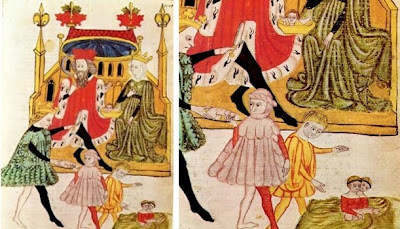
Testicles, of course, bear a likeness to grapes on the vine. These are not shown on the d'Este card; we have to wait until Noblet of c. 1650 Paris for that:
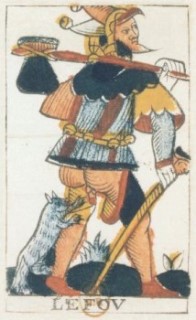
The Noblet card, in which a strange animal reaches for the genitalia of the Fool, especially suggests Virgil's 2nd Georgic (http://classics.mit.edu/Virgil/georgics.2.ii.html). In winter the goats and other animals eat the tender bark of the vines, and
...For no offence but this to Bacchus bleeds
The goat at every altar...
Therefore to Bacchus duly will we sing
Meet honour with ancestral hymns, and cakes
And dishes bear him; and the doomed goat
Led by the horn shall at the altar stand,
Whose entrails rich on hazel-spits we'll roast
So a young goat is sacrificed to atone for the crime of his siblings, of eating the bark of the vines when they could and so damaging the crop. My knowledge of this Georgic comes again from Cartari, 1551. If Cartari knew it, others did before him. The Getty Museum has a Roman-era statue from Sicily done in archaic style that depicts just this crime, with Dionysus impersonating the grape vine (center and right, below):
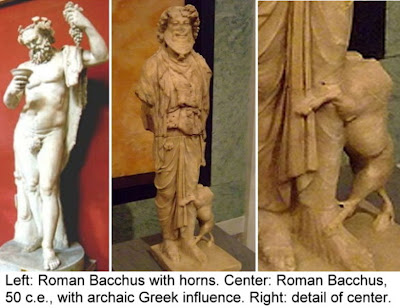
Whether such statues were seen in the Renaissance, I don't know. On the left above is another showing Dionysus with horns; in the myths, he himself had taken the form of a young goat, etc. Another example is a Roman mosaic that Daimonax on http://bacchos.org/tarothtm/0et9mathermite2.html says is from the area around Narbonne, France:
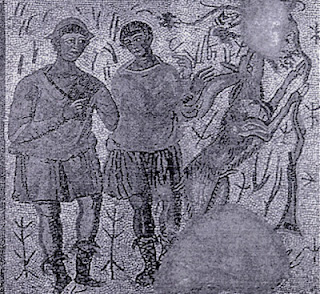
To 15th century Christians, this goat-sacrifice would have been an "anticipation", as it was called, of Christ's own sacrifice, for the sake of atoning for humanity's eating of forbidden fruit. It is the sacrifice of the earthly part for the sake of the heavenly.
In this connection it would be of interest to look at the etymology of "matto". I don't know what the Italian etymology books say, but for the English equivalent, "mad", my 1967 Webster's New World Dictionary takes us back to what it says is the Indo-European root:
§ «matt-, to cut down < mai, to hew, cut off; prob. sense development; castrated, crippled--mentally deficient» §
I cannot help but think that there is a relationship here to the "mate" in "checkmate", which my dictionary says comes from the Persian shah plus mat, literally, "the king is dead". There is also the word "matador", the one who kills the bull, which my dictionary says comes from the Persian matar, to kill, with similar derivation as for the "mate" in "checkmate". I do not know whether the 15th century made these associations, but along these lines see the Sola-Busca Matto, with its crow, a symbol of death, and dead tree in the background:
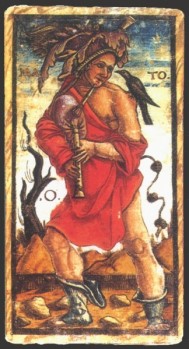
Animal sacrifice was clearly mentioned by almost all ancient authorities in relation to the cult of Dionysus, both as his animal and as he himself. Diodorus names the ram as Dionysus at 73:1, the bull at 68:2, and horned animals generally at 64:2 and 73:2, Fools of course had mock-horns on their heads. So the Fool, the Matto, would be the one to be sacrificed; thus later we see the Hanged Man and perhaps other cards after that, such as Death, Devil, and Tower.
Moreover, if castration is part of the root meaning, we are again in the territory of Dionysus/Osiris, as the one whose phallus is missing. In relation to this same dictionary description "castrated, crippled, mentally deficient", I cannot help but also think of Buckert's derivation, as quoted by Andrea in "Tharocus Bacchus Est," of "mania" from "menos," another word for deficiency.
A9: Other early Matto cards
I have mentioned the Leber Matto, c. 1500-1520, before, as an example of a "tarroco" figure in the sense of "angry".
Marcos Filesi called attention to this characterization at http://forum.tarothistory.com/viewtopic.php?f=12&t=609. He calls him (below) a "choleric fool".

Let me say again what I said in the earlier discussion: As Ross Caldwell and M. J. Hurst have explained, he has all kinds of weapons with him, but nothing for combating the insects buzzing around him (http://pre-gebelin.blogspot.com/2009/04/witless-warrior.html). The motto, Ross says, is "I wish that a net would be given to me." He is a clear example of the angry but ridiculous madman. And not only are his genitals exposed, but he is urinating uncontrollably, as Hurst points out.
What I find especially relevant about Marcos's post is that he relates the figure to the Mundus alter et idem of Joseph Hall, which he knows about from Andrea's essay on it (http://www.associazioneletarot.it/page.aspx?id=152). It is a work in Latin first published c. 1605 in Frankfurt (the 20th century editor even includes a facsimile of the title page, with the word "Francofvrti" , although not the date), with three German reprints up to 1664--Hanover 1607, Utrecht 1643, Munich 1664--and a German translation in 1613, reprinted in 1704 (modern English edition p. xxx). A rather free English translation appeared in 1609 (The Discovery of a New World, translated by John Healey, c. 1609, edited by Huntington Brown, 1937).
Hall's satire describes an imaginary land called Moronia ("Fooliana" in the translation), of which one province is Orgilia, whose capital is the city of Tarocchium. This last is a word that Hall says he gets from Garzoni (about whose work Hospital of Incurable Madmen Andrea has also written an essay). I quote from Hall's own gloss on this name, from the modern edition, p. 206; I think that the editor is giving a translation of Hall's Latin):
§ «Garzonius in his 13th Discourse says furious fools are "Da Tarocco"; whence this name» §
Later in his travels through Moronia/Fooliana, Hall's narrator even comes across a hospital run by this Garzoni, "an Italian,"; it is called "Hospitall of incurable Foolianders" (p. 118).The marginal gloss of the English version explains that "Garzoni" was the name of the author of "Hospitall of incurable fooles."
In the description of the inhabitants of Orgilia, Hall says that they arm themselves whenever they go out, and not with just one weapon (p. 95):
§ «There is none of these that euer stirre abroad vnarmed; hee that is but halfe sufficiently apparelled, will bee sure howsoeuer to haue his armour vpon him A capo a pie: and like a Porter hyred by Mars, ha's his Musket on one shoulder, and his Halberd on the tother, his sworde there, and his great bumme duagger here, with two boxe hilts, a man may boyle two joynts of meate in them, and at his back he bore his bow and shafts.
(There is none of these that ever stir abroad unarmed; he that is but half sufficiently apparelled, will be sure howsoever to have his armor upon him A capo a pie [head to foot]; and like a porter hired by Mars, has his musket on one shoulder, and his halberd on the other, his sword there, and his great bum [?] dagger here, with two box hilts, a man may boil two joints of meat in them, and at his back he bore his bow and shafts...)» §
This resident of Moronia/Fooliana is much like the Leber Fool card, taken to an even greater extreme. Then if such a person should meet anyone who will not give way to him, Hall's narrator says, he draws his weapons and demands of that person to "kiss my pumpe"--"pumpe" is an old word for "shoe"--and if not, there must be the satisfaction of his honor. And then, if the other has died, he eats his victim. The English translation is clear:
§ «If one chance to kill his enemy, hee feedes vpon him immediatly, for they eate raw flesh altogether, and drinke warme bloud, and this is the best esteemed fare.
(If one chances to kill his enemy, he feeds upon him immediately, for they eat raw flesh altogether, and drink warm blood, and this is the best esteemed fare)» §
More chances for bloodshed come whenever a person feels himself a victim of injustice. For there is no remedy for injustice except personal acts of vengeance (p. 95), and no law except "Conquer and possesse."
Although Hall never refers to the game of tarocchi, he and some of his readers must have known, about the game and its Italian name. Dummett in Game of Tarot says--I am not sure the page--that the game had reached England by 1600.
Also, Florio's 1611 Italian-English Dictionary has, for the meaning of "tarocchi", "a kind of playing cardes called Tarocks or Terestriall triumphs" (http://www.pbm.com/~lindahl/florio/search/568c.html). In 1598 he had said "cardes used in Italy" (p. 413 at http://www.pbm.com/~lindahl/florio1598/florio_1598.pdf); but in 1611 this qualifier is dropped.
At the same time, Hall's description suggests an unsympathetic account of the followers of Bacchus as described by Euripides--not drinkers, who are described elsewhere in the book as devotees of Bacchus, but people who get worked up, as in Garzoni's book, into a delusional fury (also suggested by the name, in the translation, of the river running through the capital, Furieuse). "Orgilia" suggests the Greek "orgia," despite Hall's gloss, p. 202, that it comes from "orgueil," French for "arrogance." The 20th century editor suggests a relationship to the Greek orge, meaning "wrath"; but orgia is even closer. Yet wrath is also part of the Dionysian cult. In Euripides' Bacchae, personal vengeance for Pentheus's lack of proper respect for Dionysus (refusing to allow his worship in Thebes) would seem to be the god's main motive for luring Pentheus to his death. And the result is indeed the eating of Pentheus' raw flesh by the god's followers, including his own mother. Euripides' lines are hardly flattering to those who with to emulate the followers of Dionysus. For example, having ripped her son limb from limb, under the delusion that he was a wild beast, Agave says to the Chorus (http://records.viu.ca/~johnstoi/euripides/euripides.htm):
We've had good hunting. So come, share our feast
To which the Chorus, not under her delusion, replies:
What? You want me to eat that with you?
Oh you unhappy woman
I cannot help but wonder whether the game and the cult were perhaps associated in a positive way by some people at this time--not identifying with Euripides' crazed Maenads, to be sure--and Hall wanted to satirize that association.
The Leber card itself, I want to emphasize, does not seem to me to suggest the cult of Dionysus--its inspiration is merely the idea of "tarocco" meaning "angry" (and the "perturbatio" of the Greek tarachos). Only to someone who associated inappropriate defensiveness with Dionysus--as a reader of Euripides might--would make such an association.
The PMB Matto likewise dos not suggest anything Dionysian, at least not directly. But in the context of Carnival and Lent there may be an indirect connection, and also in the sense of the depressed phase following mania.
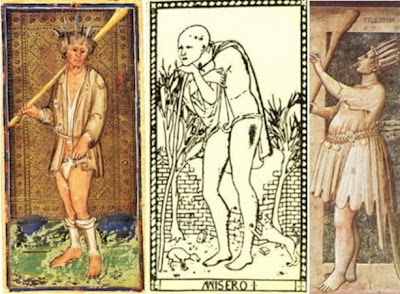
With his seven feathers, Moakley (The Tarot Cards Painted by Bonifacio Bembo, p. 115) compared him to the Lenten Fool, succeeding the Carnival Fool, whom she identifies with the PMB card. The feathers represent the weeks in Lent: Giotto's stultia, the Vulgate's word for "folly," also has these feathers (on the right in the image). The round belly indicates pregnancy, Moakley says. It could also be the hypocrisy of the well-fed who affect poverty at Lent. Or perhaps the naive joy of someone fed well at Carnival, not realizing that he will be starved for seven weeks and then sacrificed.
(The "Fish-Eaters" website, http://www.fisheaters.com/customslent2.html, says:
§ «In many places in Italy, Lent is personified by the effigy of an old woman that is displayed during Lent, and then burned at the stake (sometimes after a "trial") at the end of the season» §
It is only to the extent that Easter retains vestiges of old pagan cults of animal sacrifice that the PMB card has the suggestion of Dionysus here--the goat who was sacrifrced as punishment for all the damage done by goats to the vines, according to Virgil.
Also, the PMB Matto fits the Dionysian mold in another broad sense, of "tarocco" as "manic", as in the mania of the Maenads. He could be exhibiting the state of a gambler who has lost everything, the depressed phase following the mania of playing and winning - a depression clearly indicated in the Tarot of Mantegna figure and title - or the inflated hero, like Oedipus quick to anger, after his downfall, or Pentheus's mother Agave after she realized that she has killed and eaten her son's flesh. Such a Matto has attained some wisdom, at least about his former life, and perhaps his spiritual life is about to begin. But any such connection to Dionysus is in the eye of the beholder.
On the other hand, it seems to me that the Cary Sheet Matto, on the right below, from c. 1500 or a little earlier, gives us a stronger hint of the Wise Fool:
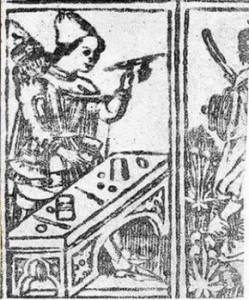
Even though his leggings are still around his feet, his gait seems purposeful, like that of a pilgrim, and on his back he has a three-tiered hat or pack. Its threeness might suggest a kinship with the Pope, who usually has a three-tired tiara, but also the legendary Hermes Trismegistus, the Thrice-great. The Cary Sheet Bagatino has something similar on his back.
The Sicilian Tarot today has two Fools, one a beggar and the other a court jester or professional Fool.
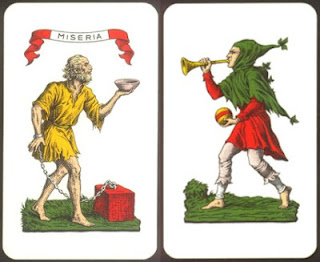
Although this tarot seems to have been introduced into Sicily in 1660 or so (from Spain?), the tradition might be an old one (I get these images from "Huck" at http://forum.tarothistory.com/viewtopic.php?f=11&t=782&p=11519#p11519). These might suggest a sense of the ignorant or unwise fool on the one hand and the wise fool on the other. Court jesters were valued for satirizing not only others but also the lord they served, offering him wise counsel in an entertaining form. The Fool in Shakespeare's King Lear is of that sort. That play trades on the wise fool/ignorant fool distinction in other ways as well: Lear is foolish when he speaks most clearly, and wisest when he is most inarticulate. And Gloucester's son wisely pretends to be "Mad Tom," a former profligate reduced to beggary and madness.
Another deck, from France that might be counted as one with two Fools, according to "Huck," on THF, is the Minchiate Franchesi, which is dated to c.1660 (http://forum.tarothistory.com/viewtopic.php?f=11&t=782). Huck observes that the dating comes from a publication in which the noted French card historian Thiery Depaulis participated (http://www.millon-associes.com/doc/CP-Carte-a-jouer-051111.pdf).
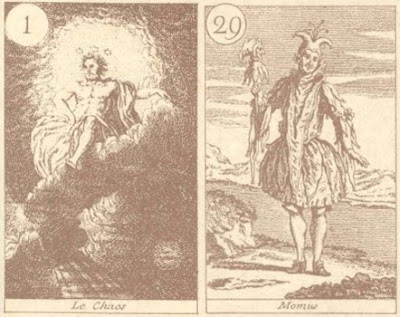
"Chaos," I think, would be the upper Folly, and "Momus" the lower one. I am not sure that they divide into "wise" and "ignorant," however. These two names are in Hesiod's genealogy of the gods, (http://en.wikipedia.org/wiki/Nyx_%28mythology%29), in which Chaos is first and Momus his grandson, a god who mocks the others, In the illustration, however, Momus appears merely a court jester. There is slight a connection to Ferrara: Alberti wrote a long narrative called Momus just after the period he was friendly with Leonello d'Este, tarly he 1440s. In the first part ofAlberti's text, "Huck" points out, Momus praises the beggar.
Finally, we must not forget Matteo Boiardo's tarocchi poem of sometime between 1460 and 1490 (http://www.tarotpedia.com/wiki/Boiardo_Tarocchi_Poem:_Chapter_5_-_Triompho_Del_Vano_Mondo; I thank "Huck" again, for reminding me of this poem). Boairdo, too, was a Ferrara courtier, serving as governor of Reggio, a d'Este domain (http://en.wikipedia.org/wiki/Matteo_Maria_Boiardo).
Mondo, da pazzi vanamente amato,
Portarti un fol su l'asino presume,
Ché i stolti sol confidano in tuo stato.
(World, you are vainly loved by the mad,
And a fool thinks he can bring you on his donkey,
Because the stupid only trust your state).
The donkey here is perhaps reminiscent of Silenus's, who in his depiction as a perennial drunk is often made foolish (I owe this observation to "Huck"). However Silenus is not one who chases the materialism of the world and to that extent must be classed among the wise. Another example is the ass that Apuleius's hero is turned into in The Golden Ass, clearly a consequence of his lack of wisdom. But donkeys are proverbially associated with both fools and wisdom: "Ass" was a synonym for "fool" tin the Renaissanceas now, as can be seen in the pun on "Asso" meaning "Ace" in Aretino's Lampoon for the election of Adrian VI (see Andrea's Tarot in Literature I at http://www.letarot.it/page.aspx?id=199&lng=eng). But there is also Balaam's ass in the Bible. In that case, Balaam is the ignorant and the ass the wise one. And there is the ass's foal that Jesus rides into Jerusalem on, making Jesus the fool, just as he is for Erasmus
Boiardo, it seems to me, had two fools in his imagined deck. Where the first started out his poem on the trumps, the other is near the end:
Oblivion di termine e confine
Del tutto sei, Elice e Dido a Lethe
Menasti, e famma e tempo hai in toe ruine.
(Oblivion, you are the end and boundary
Of all, you took to Lethe Elice and Dido,
And among your ruins you have fame and time)
"Lethe" is the river Lethe which wipes out all memory of one's past life, here probably compared to senility. The other reference is to Petrarch's Triumphs, in which Time triumphs over Fame; but for Petrarch Eternity is what triumphs over Time, the domain of the Wise Fool.
In any case, the path is set out for us, the "the path of the fool/madman," I would call it, from deficiency into fullness, whether in Christianity or in the so-called "mystery cults" of antiquity as identified with Dionysus and Orpheus.
A10: The other cards, and an objection
I have so far only talked about the Matto card. For there to be a "path of the Matto" there must also be Dionysian interpretations for the other Triumphs, leading in the direction of the Holy Fool. It seems to me that in 1505 this would have been a project rather than a complete interpretation. People would have played with the idea. The tarot was not originally designed for such interpretation. The early cards, with the exception of the Fool cards I have mentioned and maybe a few more, do not reflect such an interpretation, which would have to be made without regard to pictorial details. With the Cary Sheet triumph cards, anticipating the later "Marseille" pattern, more details emerge consistent with the theme; and there is also the shift to what has been called the "C" order of the cards to consider. I do think it can be shown that a Dionysian interpretation of the sequence was possible, and one that influenced the design of some cards and also their order, terminating in the design known as the "Marseille II", of which the Conver of 1760-61 is the best known.
But before embarking on that project, I need to discuss one objection to what I have been saying. If there was a Dionysian interpretation of the cards, so much so that the name itself may have derived from his myth, then, one might wonder, why did no one writing about the cards, until 1781, ever mention the slightest connection to Dionysus or Osiris, or anything else, when anything was written, but good Christian meanings? My answer is that it took that long before the power of the Church, both Protestant and Catholic, was broken enough for it to be safely in one's interest to say anything else.
On this subject my information, unless otherwise stated, comes from Wikipedia. Plethon was accused of having a pagan mystery school in Greece; the only copy of his major work, the Laws, was burned by the Patriarch of Constantinople, so that all that survives is quotes in the polemics written against him. His follower Sigismondo Malatesta, for building a temple in his spirit designed by Alberti (in which Plethon was buried, his body exhumed from Greece), was excommunicated in 1460. In the 1460s, a group of humanists led by Julius Laetus took Latin names as part of a secret society called the Roman Academy; soon they were accused by the Pope of paganism, imprisoned, tortured, and then, belatedly, released. Pico's work, the 900 Theses, was condemned by the Pope, who ordered all copies burned and its author brought up on charges of heresy (see Farmer's Syncretism in the West for details). In the ensuing Interrogation, only 13 of the 900 had to be retracted. In 1493 that Pope died and copies from the original printing could safely surface. In 1494 Pico and Poliziano died suddenly, after the same dinner, in 1494; a recent exhumation found traces of arsenic in both bodies..Although nothing traces their deaths to the Church, the fear would have remained. Reuchlin, who had ruled against burning all Jewish books. in 1513, was put on trial by the Roman Inquisition for heresy; it took him years of trouble and expense before the Inquisition dropped his case. Cornelius Agrippa was hounded all his life for being a "Judaizing heretic" and a black magician. Just before 1600 Giordano Bruno thought Venice would be safe, but was taken to Rome and burned at the stake. Even in 1750s Paris, a few women who tried to tell fortunes were vilified and imprisoned, according to an account approved by Etteilla. (Wicked Pack of Cards pp. 96-97, quotes from some version of this 1791 source but not mentioning the prison terms, which I get from its reprint in the booklet that accompanies France Cartes' Petit Etteilla deck.) Without some very high-up assurances, such as de Gebelin probably had, one had to act cautiously and never say or picture anything that could not be adequately defended as orthodox. One would be mad to do otherwise. Yet we know that the Renaissance delighted in double meanings. Dummett, Depaulis, and Decker spell out the issue (Wicked Pack of Cards pp. 33-34):
§ «People of the Renaissance reveled in hidden symbolism, and the occult sciences enjoyed greater prestige in the Christian world than at any other time before or since. Any theory to this effect must pass a severe test, however. It must depend, not on any direct evidence that can be cited, but on the intrinsic plausibility that of the particular interpretation proposed, which must draw on nothing that was not available at that time and place. But it ought not to be too plausible; it cannot be anything which, if present, would leap to the eye of a man of the Renaissance looking at the cards» §
The reason they give for the symbolism not being too plausible is that otherwise we would know of it, from people ridiculing the cards. (Another reason, it seems to me, for restraint might be that silence was deemed better than publicity. And if people on their deathbeds finally wrote the truth, no doubt anxious heirs burned the essay, for fear of besmirching the family name.) The problem is that interpretations not spoken of get forgotten. And so, like fools, we are left with hypotheses--and cards, like some of the Leber, that look more and more as though being bent in a certain direction. In this situation, all we can do is put ourselves back into those times and think about the associations that, it seems to me, people of a certain type, reading literature that was publicly available, could hardly have avoided making.
This essay continues at: Dionysus and the Historical Tarot 3.